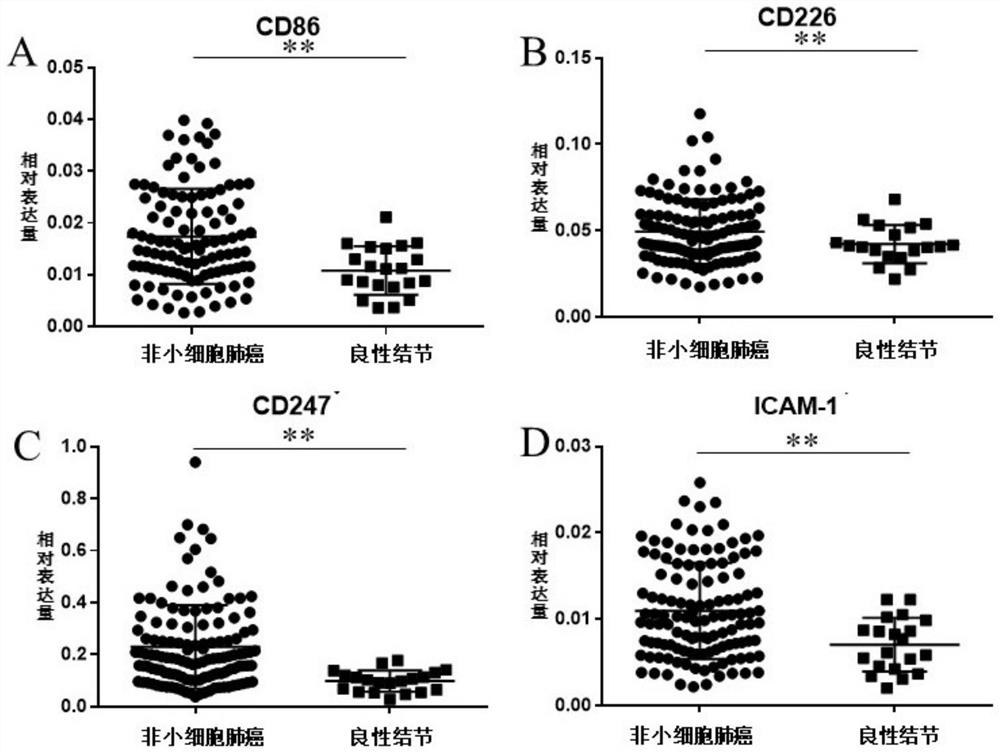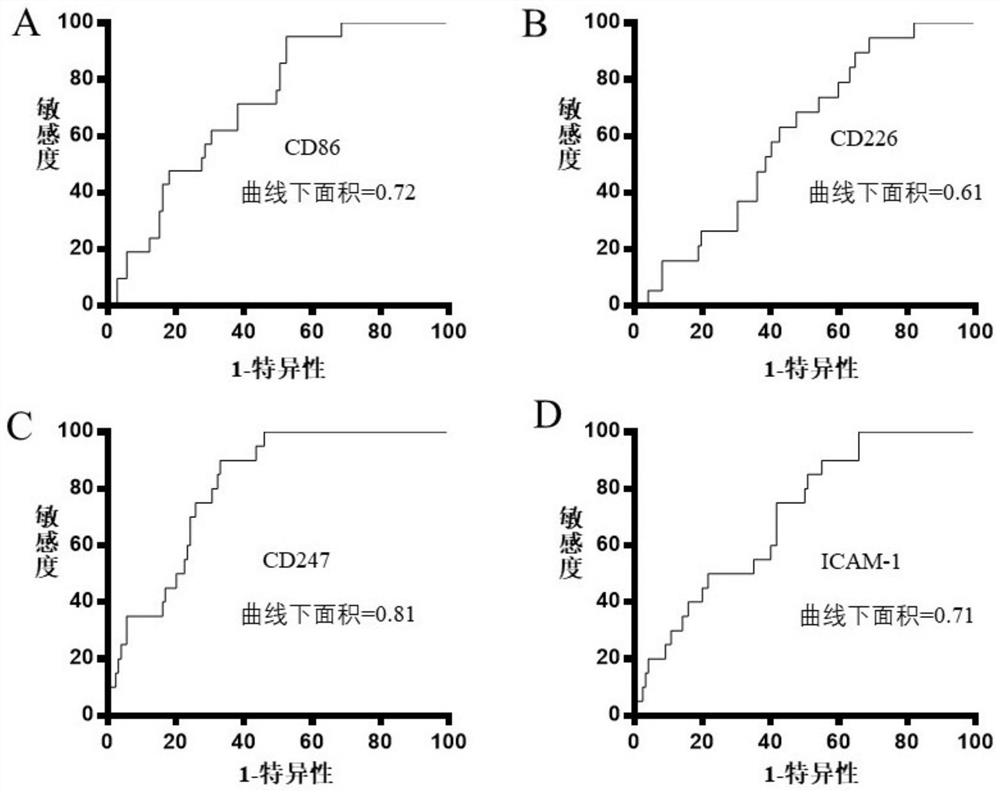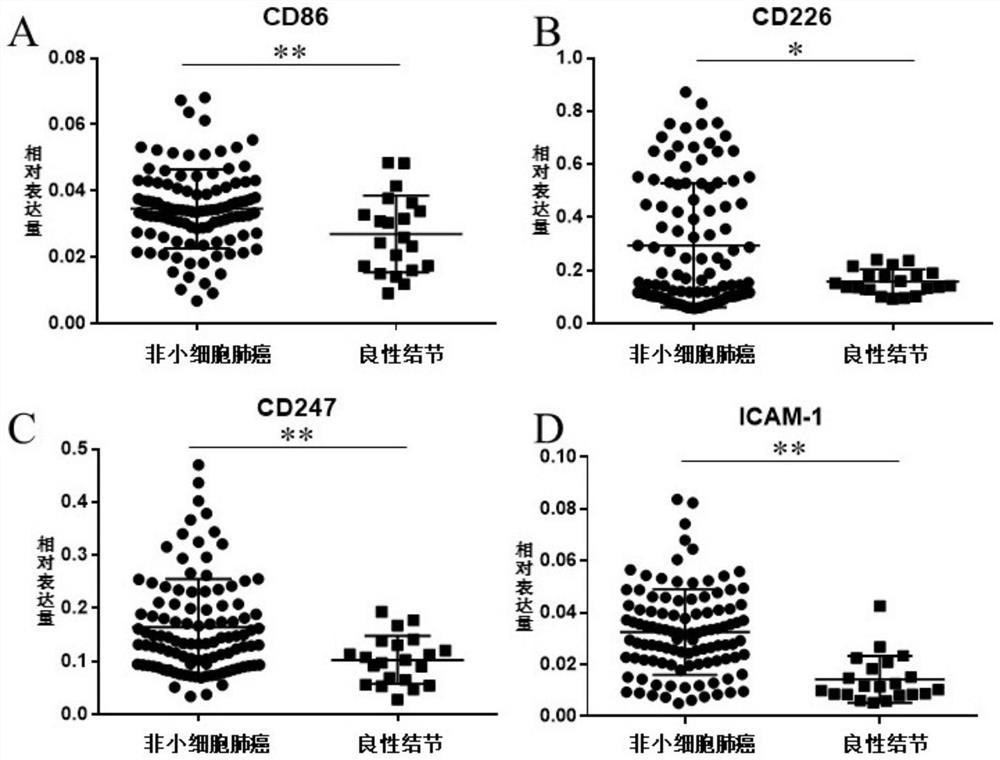Molecular markers in peripheral blood mononuclear cells for early diagnosis of non-small cell lung cancer
A non-small cell lung cancer, auxiliary diagnosis technology, applied in the biological field, can solve problems such as single diagnostic feature
- Summary
- Abstract
- Description
- Claims
- Application Information
AI Technical Summary
Problems solved by technology
Method used
Image
Examples
Embodiment 1
[0126] Example 1. Discovery of molecular markers for early diagnosis of non-small cell lung cancer
[0127] 1. Detection of the expression levels of CD86, CD226, CD247 and ICAM-1 in PBMCs of patients in the experimental group
[0128] 1) Clinical data of the subjects in the experimental group
[0129] The experimental group included 105 patients with non-small cell lung cancer (NSCLC group) and 20 patients with benign lung nodules (BENIGN group). The NSCLC group (91.4% for stage I, 4.8% for stage II, 2.9% for stage III, 0 for stage IV, 0.9% unknown) included 87 (82.9%) with adenocarcinoma and 18 (17.1%) with squamous cell carcinoma. The specific clinical information is shown in Table 7. It can be seen that there is no difference between the NSCLC group and the BENIGN group in terms of age, sex and smoking (all P values are greater than 0.05).
[0130] Table 7 is a list of clinical data of the subjects in the experimental group
[0131]
[0132]
[0133] NOTE: P-valu...
Embodiment 2
[0183] Example 2, the application of the expression of CD226 and CD247 in detecting whether the examinee suffers from non-small cell lung cancer
[0184] 1. Detection of the expression levels of CD226 and CD247 in the PBMC of the subject
[0185] 1. Separation and detection of the PBMC of the examinee: 32 cases of non-small cell lung cancer (pathological diagnosis is in the I stage) and 17 patients with benign pulmonary nodules (clinically diagnosed) as the examinee, the method is the same as that of Example 1 Same as 2.1;
[0186] 2. Extraction and purification of total RNA in PBMC: the method is the same as 2.2 of Example 1-1;
[0187] 3. The reverse transcription of the PBMC RNA sample: the method is the same as the 2.3 of the first one of the embodiment 1;
[0188] 4. qRT-PCR:
[0189] Using the reverse-transcribed cDNA in the above 3 as a template, qRT-PCR was performed with primers CD226-F / CD226-R and CD247-F / CD247-R in Table 4, respectively; GAPDH was used as an inte...
Embodiment 3
[0209] Example 3, the application of the expression levels of CD226 and CD247 and the amount of smoking of the examinee in detecting whether the examinee suffers from non-small cell lung cancer
[0210] 1. Detect the expression levels of CD226 and CD247 in the PBMC of the subject
[0211] 1. Separation and detection of the PBMC of the examinee: 32 cases of non-small cell lung cancer (pathologically diagnosed as stage I) and 17 patients with benign pulmonary nodules (clinically diagnosed) as the examinee, the method is the same as that of Example 1 Same as 2.1;
[0212] 2. Extraction and purification of total RNA in PBMC: method is the same as 2.2 of embodiment 1-1;
[0213]3. The reverse transcription of the PBMC RNA sample: the method is the same as the 2.3 of the first one of the embodiment 1;
[0214] 4. qRT-PCR:
[0215] Using the reverse-transcribed cDNA in the above 3 as a template, qRT-PCR was performed with primers CD226-F / CD226-R and CD247-F / CD247-R in Table 4, res...
PUM
| Property | Measurement | Unit |
|---|---|---|
| Sensitivity | aaaaa | aaaaa |
Abstract
Description
Claims
Application Information
 Login to View More
Login to View More - R&D
- Intellectual Property
- Life Sciences
- Materials
- Tech Scout
- Unparalleled Data Quality
- Higher Quality Content
- 60% Fewer Hallucinations
Browse by: Latest US Patents, China's latest patents, Technical Efficacy Thesaurus, Application Domain, Technology Topic, Popular Technical Reports.
© 2025 PatSnap. All rights reserved.Legal|Privacy policy|Modern Slavery Act Transparency Statement|Sitemap|About US| Contact US: help@patsnap.com



